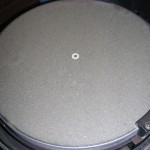At the Mauna Kea Visitor Information Station telescopes are available every clear night for the public to enjoy the wonders of the night sky. Every evening a set of telescopes ranging from 102mm to 16 inches is setup in the patio beside the VIS. The gear is used heavily, every night of the year, the wear on the telescopes does exact a toll. The abuse is constant, kids hanging on the eyepiece, volunteer operators who have never used a telescope, rain, fog, blowing cinder dust. Conditions that were never foreseen by the designers and far beyond what most telescopes encounter. Sometimes the condition of the equipment is embarrassing, dirty eyepieces, groaning mounts that refuse to track, much of the gear just looks worn and tired.

My first effort last year was to clean and repair the small dobsonians used by visitors every night. Two eight inch, a six and a 4.5″ Orion dob are put out for anyone to use, from adults to children. After years of use they were in horrible shape, bearings and focusers were coming apart, collimation gone, moisture dissolving the woodwork, a finder attached with duct tape, the mirrors so covered with dust it is surprising there was much of an image to see. One of the eight inch scopes and the 4.5 inch were in pieces in the warehouse after a fix attempt by another volunteer. It took a few days of work to put all to right. Stealing parts from an older scope, repairing what could be saved, cleaning and pounding out a couple dents. Clean, re-install and re-collimate the optics. Four dobs back in service and in better shape than they had been in quite some time.

Currently, one of the three Losmandy G-11 mounts belonging to the VIS is in my garage, spread across the table in many parts. I spent a few hours yesterday dismantling the mount and cleaning the grease and cinder dust out of the bearings. It is in pretty good shape, a good cleaning, re-seat the worm gears and some new clutch pads and it will be ready for a few more years of service. I need to get some more grease before I can reassemble the mount, but otherwise everything is ready to put back together. Finish this one and there are two more like it in sore need of maintenance.
One thing at a time, of course by the time I get through it all it will be necessary to start over again…

